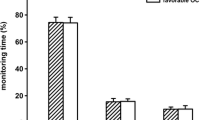Abstract
Object
Plateau waves often develop in neurointensive care patients. They are sudden increases in intracranial pressure (ICP) that lead to dramatic decreases of cerebral perfusion pressure (CPP) and can therefore contribute to ischemic secondary brain insult. The aim of this study was to analyze the occurrence of plateau waves in head injured patients requiring neurocritical care, their relation with cerebral autoregulation and impact on outcome.
Methods
Data were analyzed retrospectively in 444 head injured patients admitted to Neuroscience Critical Care Unit of Addenbrooke’s Hospital in Cambridge, UK. Arterial blood pressure (ABP), intracranial pressure (ICP), heart rate (HR) were digitally recorded and derived indices calculated. Primary monitoring data, autoregulation indices, outcome of patients, initial CT findings (in a subgroup of patients), brain tissue monitoring data (in a subgroup) were compared between patients who developed plateau waves and those who did not.
Results
Plateau waves were observed in 109/444 patients (24.5%). They were significantly more frequent in younger patients. Impaired cerebrovascular pressure reactivity and depleted compensatory reserve were associated with vasodilatation on the top of the wave. Plateau waves were not associated with poorer outcome unless the episodes lasted for a long time (longer than 30–40 min). Plateau waves were more frequently seen in patients with lesser midline shift, lower volume of contusion on CT scan, absence of skull fractures, and lower brain tissue concentration of carbon dioxide.
Conclusions
Plateau waves are frequent phenomenon. They are not associated with worse outcome unless they lead to sustained intracranial hypertension.





Similar content being viewed by others
References
Rosner MJ, Becker DP. Origin and evolution of plateau waves. Experimental observations and a theoretical model. J Neurosurg. 1984;60(2):312–24.
Hayashi M, et al. Plateau-wave phenomenon (I). Correlation between the appearance of plateau waves and CSF circulation in patients with intracranial hypertension. Brain. 1991;114(Pt 6):2681–91. doi:10.1093/brain/114.6.2681.
Hayashi M, et al. Cerebral blood flow and ICP patterns in patients with communicating hydrocephalus after aneurysm rupture. J Neurosurg. 1984;61(1):30–6.
Hayashi M, et al. Role of the medulla oblongata in plateau-wave development in dogs. J Neurosurg. 1987;67(1):97–101.
Renier D, Sainte-Rose C, Marchac D, Hirsch JF. Intracranial pressure in craniostenosis. J Neurosurg. 1982;57(3):370–7.
Lundberg N. Continuous recording and control of ventricular fluid pressure in neurosurgical patients. Acta Psychiatr Neurol Scand. 1960;149:158–67.
Daley ML, et al. Intracranial pressure monitoring: modeling cerebrovascular pressure transmission. Acta Neurochir Suppl (Wien). 2006;96:103–7. doi:10.1007/3-211-30714-1_24.
Schmidt B, et al. Cerebral vasodilatation causing acute intracranial hypertension: a method for noninvasive assessment. J Cereb Blood Flow Metab. 1999;19(9):990–6. doi:10.1097/00004647-199909000-00006.
Daley ML, et al. Plateau waves: changes of cerebrovascular pressure transmission. Acta Neurochir Suppl (Wien). 2005;95:327–32. doi:10.1007/3-211-32318-X_67.
Imberti R, et al. The use of indomethacin in the treatment of plateau waves: effects on cerebral perfusion and oxygenation. J Neurosurg. 2005;102(3):455–9.
Stevens SA, et al. A model for idiopathic intracranial hypertension and associated pathological ICP wave-forms. IEEE Trans Biomed Eng. 2008;55(2):388–98. doi:10.1109/TBME.2007.900552.
Rosner MJ, Rosner SD, Johnson AH. Cerebral perfusion pressure: management protocol and clinical results. J Neurosurg. 1995;83(6):949–62.
Patel HC, Menon DK, Tebbs S, Hawker R, Hutchinson PJ, Kirkpatrick PJ. Specialist neurocritical care and outcome from head injury. Intensive Care Med. 2002;28(5):547–53. doi:10.1007/s00134-002-1235-4.
Hiler M. Predictive value of initial computerized tomography scan, intracranial pressure, and state of autoregulation in patients with traumatic brain injury. J Neurosurg. 2006;104(5):731–7. doi:10.3171/jns.2006.104.5.731.
Czosnyka M, et al. Hemodynamic characterization of intracranial pressure plateau waves in head-injury patients. J Neurosurg. 1999;91(1):11–9.
Smielewski P, Czosnyka M, Steiner L, Belestri M, Piechnik S, Pickard JD. ICM+: software for on-line analysis of bedside monitoring data after severe head trauma. Acta Neurochir Suppl (Wien). 2005;95:43–9. doi:10.1007/3-211-32318-X_10.
Guendling K, Smielewski P, Czosnyka M, Lewis P, Nortje J, Timofeev I, et al. Use of ICM+ software for on-line analysis of intracranial and arterial pressures in head-injured patients. Acta Neurochir Suppl (Wien). 2006;96:108–13. doi:10.1007/3-211-30714-1_25.
Marshall LF, Marshall SB, Klauber MR, van Berkum Clark M, Eisenberg HM, et al. A new classification of head injury based on computized tomography. J Neurosurg. 1991;75(Suppl):S14–20.
Vik A, Nag T, Fredriksli OA, Skandsen T, Moen KG, Schirmer-Mikalsen K, et al. Relationship of “dose” of intracranial hypertension to outcome in severe traumatic brain injury. J Neurosurg. 2008;109(4):678–84. doi:10.3171/JNS/2008/109/10/0678.
Balestreri M, Czosnyka M, Hutchinson P, Steiner LA, Hiler M, Smielewski P, et al. Impact of intracranial pressure and cerebral perfusion pressure on severe disability and mortality after head injury. Neurocrit Care. 2006;4(1):8–13. doi:10.1385/NCC:4:1:008.
Hayashi M, et al. Plateau-wave phenomenon (II). Occurrence of brain herniation in patients with and without plateau waves. Brain. 1991;114(Pt 6):2693–9. doi:10.1093/brain/114.6.2693.
Acknowledgment
The authors are in debt to all the team participating in data collection: Mrs. Pippa Al-Rawi, Mrs. Helen Seley, Mrs. Carole Turner, Dr. Marcella Balestreri, Dr. Magda Hiler, Dr. Luzius Steiner, Dr. Eric Schmidt, Dr. Stefan Piechnik, Dr. Andreas Raabe, Mr. Eric Guazzo, Dr. David Menon, Dr. Arun Gupta, Dr. Basil Matta, Mr. Peter Kirkpatrick, Mr. Ivan Timofyeyev, Mr. Pwawanjit Minhas, Mr. Rodney Laing, and all nursing and research staff of NCCU and Wolfson Brain Imaging Centre. The project was supported by National institute of Health Research Biomedical Research center, Cambridge University Hospital Foundation Trust—Neurosciences Theme. Further support was achieved from the Swiss National Science Foundation (PBBSP3-125550 to CZ and PASSMP3-124262 to EC), Bern, Switzerland. EC was additionally supported by the SICPA Foundation, Lausanne, Switzerland.
Disclosure
ICM+ software (www.neurosurg.cam.ac.uk/icmplus) is licensed by University of Cambridge, Cambridge Enterprise Ltd. PS and MC have a financial interest in a part of licensing fee. Dr. Marek Czosnyka is on unpaid leave from Warsaw University of Technology.
Author information
Authors and Affiliations
Corresponding author
Rights and permissions
About this article
Cite this article
Castellani, G., Zweifel, C., Kim, DJ. et al. Plateau Waves in Head Injured Patients Requiring Neurocritical Care. Neurocrit Care 11, 143–150 (2009). https://doi.org/10.1007/s12028-009-9235-7
Received:
Accepted:
Published:
Issue Date:
DOI: https://doi.org/10.1007/s12028-009-9235-7



